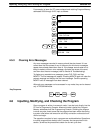
43
If 0000 in the above diagram was OFF (i.e., if the execution condition for the
first INTERLOCK instruction was OFF), instructions 1 through 4 would be
executed with OFF execution conditions and execution would move to the
instruction following the INTERLOCK CLEAR instruction. If 0000 was ON, the
status of 0001 would be loaded to form the execution condition for instruction
1 and then the status of 0002 would be loaded to form the first execution
status for that instruction line, i.e., the execution condition for the second IN-
TERLOCK instruction. If 0002 was OFF, instructions 2 through 4 would be
executed with OFF execution conditions. If 0002 was ON, 0003, 0005, and
0006 would be executed as written.
4-3-9 Jumps
A specific section of a program can be skipped according to a designated
execution condition. Although this is similar to what happens when the exe-
cution condition for an INTERLOCK instruction is OFF, with jumps, the oper-
ands for all instructions maintain status. Jumps can therefore be used to con-
trol devices that require a sustained output, e.g., pneumatics and hydraulics,
whereas interlocks can be used to control devices that do not required a sus-
tained output, e.g., electronic instruments.
Jumps are created using the JUMP (JMP(04)) and JUMP END (JME(05))
instructions. If the execution condition for a JUMP instruction is ON, the pro-
gram is executed normally as if the jump did not exist. If the execution condi-
tion for the JUMP instruction is OFF, program execution moves immediately
to a JUMP END instruction without changing the status of anything between
the JUMP and JUMP END instruction. Actually there are two types of jumps.
All JUMP and JUMP END instructions are assigned jump numbers ranging
between 00 and 08. The jump number used determines the type of jump.
A jump can be defined using jump numbers 01 through 08 only once, i.e.,
each of these numbers can be used once in a JUMP instruction and once in
a JUMP END instruction. When a JUMP instruction assigned one of these
numbers is executed, execution moves immediately to the JUMP END in-
struction that has the same number as if all of the instruction between them
did not exist. Diagram B from the TR bit and interlock example could be
redrawn as shown below using a jump. Although 01 has been used as the
jump number, any number between 01 and 08 could be used as long as it
has not already been used in a different part of the program.
Instruction 1
0002
0000
Instruction 2
Diagram B: Corrected with a Jump
0001
JME(05) 01
JMP(04) 01
Address Instruction Operands
0000 LD 0000
0001 JMP(04) 01
0002 LD 0001
0003 Instruction 1
0004 LD 0002
0005 Instruction 2
0006 JME(05) 01
This version of diagram B would have a shorter execution time when 0000
was OFF than any of the other versions.
The other type of jump is created with a jump number of 00. As many jumps
as desired can be created using jump number 00 and JUMP instructions us-
ing 00 can be used consecutively without a JUMP END using 00 between
them. In the extreme, only one JUMP END 00 instruction is required for all
JUMP 00 instructions. When 00 is used as the jump number for a JUMP in-
struction, program execution moves to the instruction following the next
The Ladder Diagram Section 4-3


















